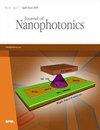Generation of all-optical Walsh–Hadamard code using silicon micro-ring resonator
IF 1.1
4区 物理与天体物理
Q4 NANOSCIENCE & NANOTECHNOLOGY
引用次数: 0
Abstract
Silicon micro-ring resonator-based generation of all-optical (2×2) Walsh–Hadamard code is proposed. The energy-efficient, ultra-high-speed, and compact nature of micro-ring resonator-based devices is essential for optical computing. Both MATLAB and the Ansys Lumerical finite difference time domain (FDTD) approach are used to implement the generation of all-optical (2×2) Walsh–Hadamard code. The proposed design is simulated at about 260 Gbps. In the recommended circuit, the needed pump power for switching is merely 0.84 mW, which is extremely little in contrast. The “figure of merits” of the proposed design is evaluated through numerical simulation. The obtained contrast ratio and extinction ratio are considerably greater at 25.24 and 14.63 dB, respectively. On the other hand, the achieved amplitude modulation of 0.13 dB is extremely low. The on-off ratio for a single micro-ring resonator is 36.9 dB.利用硅微环谐振器生成全光沃尔什-哈达玛德码
提出了基于硅微环谐振器生成全光(2×2)沃尔什-哈达玛码的方法。基于微环谐振器的器件具有高能效、超高速和紧凑的特性,这对于光学计算至关重要。MATLAB 和 Ansys Lumerical 有限差分时域 (FDTD) 方法被用于实现全光 (2×2) 沃尔什-哈达玛代码的生成。对拟议设计进行了约 260 Gbps 的模拟。在推荐的电路中,开关所需的泵功率仅为 0.84 mW,相比之下微不足道。通过数值模拟评估了拟议设计的 "优点"。所获得的对比度和消光比分别为 25.24 和 14.63 dB,都大大提高了。另一方面,0.13 dB 的振幅调制非常低。单个微环谐振器的开关比为 36.9 dB。
本文章由计算机程序翻译,如有差异,请以英文原文为准。
求助全文
约1分钟内获得全文
求助全文
来源期刊

Journal of Nanophotonics
工程技术-光学
CiteScore
2.60
自引率
6.70%
发文量
42
审稿时长
3 months
期刊介绍:
The Journal of Nanophotonics publishes peer-reviewed papers focusing on the fabrication and application of nanostructures that facilitate the generation, propagation, manipulation, and detection of light from the infrared to the ultraviolet regimes.
 求助内容:
求助内容: 应助结果提醒方式:
应助结果提醒方式:


